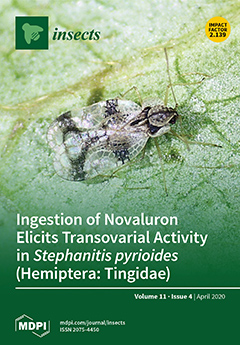Autophagy is a highly conserved and regulated process in eukaryotic cells and remodels cytoplasm, recovers essential nutrients, and disposes of unwanted cytoplasmic components. Autophagy-related gene (ATG) 8, identified in
Heortia vitessoides Moore, which is an oligophagous pest of
Aquilaria sinensis (Lour.), was characterized
[...] Read more.
Autophagy is a highly conserved and regulated process in eukaryotic cells and remodels cytoplasm, recovers essential nutrients, and disposes of unwanted cytoplasmic components. Autophagy-related gene (ATG) 8, identified in
Heortia vitessoides Moore, which is an oligophagous pest of
Aquilaria sinensis (Lour.), was characterized (
HvATG8). Multiple sequence alignment showed that
HvATG8 possesses highly conserved domain structures. Stage- and tissue-specific expressions indicated that
HvATG8 is highly expressed in prepupal, pupal, and adult stages and in the midgut of larvae and abdomen of adults. Lack of function of
HvATG8 by RNA interference resulted in a significant decrease in survival rate and an increase in abnormal or nonviable phenotypes in
H.
vitessoides. Transition rate from larval to pupal stages was 33.0% and from pupal to adult stages was 15.0% after injection. Reduction of ATG8 expression reduced survival of
H.
vitessoides. Therefore,
HvATG8 possibly plays a key role in normal growth stage of
H.
vitessoides.
HvATG8 suppression downregulates
HvATG3 expression, suggesting that the two genes are interconnected. Further,
HvATG8 expression increased by 20-hydroxyecdysone treatment, starvation, and extreme temperature exposure. Starvation also altered expression of other ATGs in
H.
vitessoide. This study may be used to guide research on molecular mechanisms of autophagy in insects.
Full article






